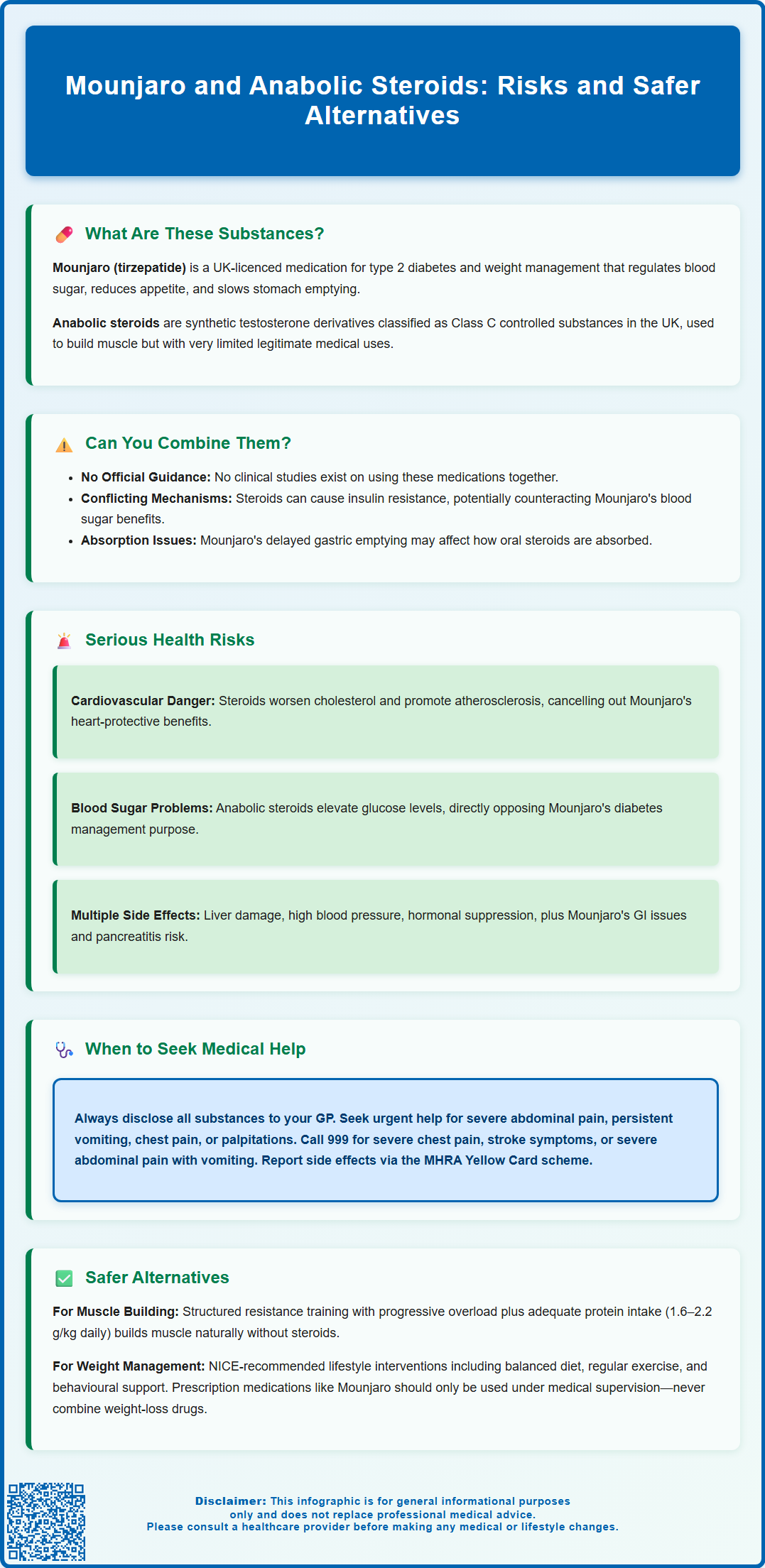Mounjaro®
Dual-agonist support that helps curb appetite, hunger, and cravings to drive substantial, sustained weight loss.
- ~22.5% average body weight loss
- Significant weight reduction
- Improves blood sugar levels
- Clinically proven weight loss

Mounjaro (tirzepatide) is a dual GIP/GLP-1 receptor agonist licensed in the UK for type 2 diabetes and weight management, whilst anabolic steroids are Class C controlled substances primarily misused for muscle growth. Combining Mounjaro and anabolic steroids raises important safety concerns, as these medications have opposing metabolic effects and no formal interaction studies exist. Anabolic steroid misuse can induce insulin resistance and cardiovascular risks that may counteract Mounjaro's therapeutic benefits. This article examines the pharmacology of both drug classes, potential risks of concurrent use, and evidence-based alternatives for achieving weight management and muscle development goals safely under medical supervision.
Summary: There is no official UK guidance on combining Mounjaro (tirzepatide) with anabolic steroids, and concurrent use may cause metabolic conflicts and increased cardiovascular risks.
Mounjaro (tirzepatide) is a prescription medicine licensed in the UK for the treatment of type 2 diabetes mellitus and, more recently, for chronic weight management in adults with obesity or overweight with weight-related comorbidities, as per the MHRA authorisation. It belongs to a class of medications known as dual glucose-dependent insulinotropic polypeptide (GIP) and glucagon-like peptide-1 (GLP-1) receptor agonists. Mounjaro works by mimicking the action of incretin hormones, which help regulate blood glucose levels by stimulating insulin secretion when blood sugar is elevated, suppressing glucagon release, and slowing gastric emptying. These mechanisms collectively reduce appetite and promote weight loss, making it an effective option for individuals struggling with metabolic conditions. Importantly, the delayed gastric emptying can affect the absorption of some oral medicines.
Anabolic steroids are synthetic derivatives of testosterone designed to promote muscle growth (anabolism) and enhance physical performance. In the UK, anabolic-androgenic steroids (AAS) are Class C controlled substances under the Misuse of Drugs Act 1971 (Schedule 4 Part II). While possession for personal use is not illegal, supplying them to others is an offence, and import/export restrictions apply. Medically, testosterone is primarily prescribed for hypogonadism in men, with other AAS having very limited clinical applications in current UK practice. However, they are frequently misused in bodybuilding and athletic contexts to accelerate muscle development and improve strength. Common examples include nandrolone, stanozolol, and testosterone esters.
These two classes of medication serve fundamentally different purposes: Mounjaro targets metabolic health and weight reduction, whilst anabolic steroids aim to increase muscle mass and physical performance. Understanding their distinct mechanisms and intended uses is essential when considering any potential interaction or combined use.

There is currently no official clinical guidance from the MHRA, NICE, or the manufacturer of Mounjaro specifically addressing the concurrent use of tirzepatide with anabolic steroids. This absence reflects the fact that anabolic steroids are not routinely prescribed alongside diabetes or weight-management medications in standard clinical practice, and formal drug interaction studies have not been conducted between these two classes.
From a pharmacological perspective, Mounjaro and anabolic steroids operate through different mechanisms and metabolic pathways. Tirzepatide acts on incretin receptors to modulate glucose homeostasis and appetite regulation, whilst anabolic steroids bind to androgen receptors to promote protein synthesis and muscle hypertrophy. While tirzepatide is not significantly metabolised by cytochrome P450 enzymes, it does delay gastric emptying, which can alter the absorption and exposure of some oral medications. This effect has been documented with oral contraceptives and could potentially impact oral anabolic steroids, though specific data are lacking.
The metabolic effects of these medications may conflict. Non-medical, supraphysiological use of anabolic steroids can induce insulin resistance and adversely affect lipid profiles, potentially counteracting the glycaemic and metabolic benefits of Mounjaro. However, therapeutic testosterone replacement in hypogonadal men may have different metabolic effects. Additionally, individuals using anabolic steroids non-medically are often pursuing body composition goals that may conflict with the weight-loss effects of tirzepatide.
Anyone considering using both medications—whether for legitimate medical reasons or otherwise—should consult a healthcare professional. Self-medicating or combining prescription drugs with controlled substances without medical supervision significantly increases the risk of adverse outcomes and undermines the therapeutic goals of treatment. Closer monitoring of blood glucose would be advisable if both are used.
Combining Mounjaro with anabolic steroids introduces several metabolic and cardiovascular risks that warrant careful consideration. Non-medical, supraphysiological use of anabolic steroids can cause insulin resistance, elevate blood glucose levels, and worsen glycaemic control—effects that may oppose the therapeutic aims of Mounjaro in managing type 2 diabetes. This metabolic conflict could reduce the efficacy of tirzepatide, necessitating closer monitoring and potentially increasing the risk of hyperglycaemia. If tirzepatide is used with insulin or sulfonylureas, dose adjustments of these medications may be needed to prevent hypoglycaemia.
Cardiovascular complications represent another significant concern. Anabolic steroid misuse is associated with adverse changes in lipid profiles, including reduced high-density lipoprotein (HDL) cholesterol and elevated low-density lipoprotein (LDL) cholesterol and triglycerides. These changes increase the risk of atherosclerosis, myocardial infarction, and stroke. While tirzepatide can improve cardiometabolic risk factors such as weight, blood pressure, and lipid profiles, the concurrent use of anabolic steroids may counteract these improvements and compound overall cardiovascular risk, particularly in individuals with pre-existing heart disease or multiple risk factors.
Anabolic steroids also carry a substantial burden of adverse effects independent of any interaction with Mounjaro. These include hepatotoxicity (especially with oral formulations), hypertension, left ventricular hypertrophy, mood disturbances, aggression, and suppression of natural testosterone production leading to hypogonadism upon cessation. In men, gynaecomastia and testicular atrophy are common; in women, virilisation effects such as deepening voice and hirsutism may occur.
Mounjaro itself can cause gastrointestinal side effects including nausea, vomiting, diarrhoea, and constipation, particularly during dose escalation. There is also a risk of gallbladder disease (cholelithiasis, cholecystitis), acute kidney injury secondary to dehydration from gastrointestinal effects, and rare but serious risks such as pancreatitis and thyroid C-cell tumours (observed in animal studies). Combining these side-effect profiles without medical oversight increases the complexity of managing any adverse events that arise.
Medical supervision is essential for anyone prescribed Mounjaro, and this becomes even more critical if anabolic steroid use—whether prescribed or non-medical—is involved. Patients should disclose all medications, supplements, and substances they are using to their GP or specialist, as this information is vital for safe prescribing and monitoring. Confidentiality is maintained, and healthcare professionals are there to support patient safety, not to judge.
For individuals prescribed Mounjaro for type 2 diabetes or weight management, regular monitoring should include HbA1c, fasting glucose, lipid profiles, renal function, and blood pressure, in line with NICE guidance (NG28 for type 2 diabetes, CG189 for obesity). If anabolic steroids are being used, additional monitoring of liver function tests, full blood count, haematocrit (risk of erythrocytosis), and cardiovascular parameters is advisable given the hepatotoxic and cardiotoxic potential of AAS.
Patients should seek urgent medical advice if they experience symptoms such as severe abdominal pain (which may indicate pancreatitis), persistent nausea or vomiting, signs of hypoglycaemia (sweating, tremor, confusion), chest pain, palpitations, or any unusual symptoms. For severe chest pain, stroke symptoms, or severe abdominal pain with vomiting, call 999 or attend A&E immediately. For urgent but non-emergency concerns, contact NHS 111. Suspected side effects should be reported via the MHRA Yellow Card scheme (yellowcard.mhra.gov.uk or the Yellow Card app).
For individuals using anabolic steroids non-medically, harm reduction services are available through some NHS trusts and specialist clinics. These services provide confidential advice, needle exchange programmes, and support for safer use or cessation. The Talk to Frank website (www.talktofrank.com) and local drug and alcohol services can provide further information and referral pathways.
Healthcare professionals should adopt a non-judgemental, patient-centred approach when discussing anabolic steroid use, recognising that many users are reluctant to disclose due to stigma. Open dialogue enables better risk assessment and tailored advice, ultimately improving patient outcomes and safety.
For individuals seeking to achieve both weight management and muscle development goals, there are evidence-based approaches that do not involve the risks associated with combining Mounjaro and anabolic steroids. A comprehensive strategy addressing diet, exercise, and appropriate medical support offers sustainable and safer outcomes.
Structured resistance training is the cornerstone of muscle development and can be highly effective when combined with adequate protein intake (typically 1.6–2.2 g/kg body weight per day for those engaged in regular strength training). For people with chronic kidney disease, protein intake should be individualised with guidance from a healthcare professional or dietitian. Progressive overload—gradually increasing the weight, frequency, or intensity of exercise—stimulates muscle hypertrophy naturally without the need for anabolic steroids. Working with a qualified personal trainer or exercise physiologist can help design an individualised programme that aligns with personal goals and medical considerations.
For weight management, lifestyle interventions remain first-line treatment according to NICE guidance. This includes a balanced, calorie-controlled diet rich in whole foods, regular physical activity combining both aerobic and resistance exercise, and behavioural strategies to support long-term adherence. Referral to NHS weight management services, dietitians, or commercial programmes with evidence of effectiveness (such as those endorsed by NICE) can provide structured support.
When lifestyle measures alone are insufficient, pharmacological options such as Mounjaro, Wegovy (semaglutide), or orlistat may be appropriate for eligible individuals under medical supervision. Eligibility criteria for these medicines are defined by NICE Technology Appraisals and local NHS commissioning arrangements. Only one weight-management medicine should be used at a time, and GLP-1/GIP agents should not be combined. Women of childbearing potential should use effective contraception during treatment with tirzepatide, and barrier methods are recommended when starting treatment or increasing the dose if using oral contraceptives.
For those concerned about muscle loss during weight reduction, optimising protein intake and maintaining resistance training throughout the weight-loss phase helps preserve lean body mass. Some individuals may benefit from consultation with a sports dietitian who can provide tailored nutritional strategies.
Ultimately, patience and realistic goal-setting are crucial. Sustainable body composition changes occur gradually, and attempting to accelerate results through unsupervised drug combinations carries significant health risks that far outweigh any perceived short-term benefits. Consulting with healthcare professionals ensures that goals are pursued safely and effectively.
There is no official guidance on combining these medications, and concurrent use may cause metabolic conflicts, reduced efficacy of Mounjaro, and increased cardiovascular risks. Medical supervision is essential if both are being used.
Yes, supraphysiological doses of anabolic steroids can induce insulin resistance and elevate blood glucose levels, potentially counteracting Mounjaro's glycaemic benefits and requiring closer monitoring.
Disclose all medications and substances to your GP or specialist immediately. Regular monitoring of blood glucose, liver function, lipid profiles, and cardiovascular parameters is advisable, and harm reduction services are available for confidential support.
The health-related content published on this site is based on credible scientific sources and is periodically reviewed to ensure accuracy and relevance. Although we aim to reflect the most current medical knowledge, the material is meant for general education and awareness only.
The information on this site is not a substitute for professional medical advice. For any health concerns, please speak with a qualified medical professional. By using this information, you acknowledge responsibility for any decisions made and understand we are not liable for any consequences that may result.
Lorem ipsum dolor sit amet, consectetur adipiscing elit, sed do eiusmod tempor incididunt ut labore et dolore magna aliqua. Ut enim ad minim veniam, quis nostrud exercitation ullamco laboris nisi ut aliquip ex ea commodo consequat. Duis aute irure dolor in reprehenderit in voluptate velit esse cillum dolore eu fugiat nulla pariatur.
Block quote
Ordered list
Unordered list
Bold text
Emphasis
Superscript
Subscript